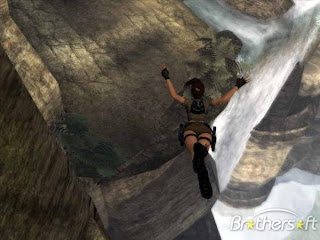 ‘That Thing’ - Lara Croft
‘That Thing’ - Lara Croft
This documentary was also mixed as there was a combination of elements within it; there was a voiceover, but this only made up a small part of the narration, as the interviewees made up most of the structure. There was also archive footage and evidence to support what the interviewees were saying, including ‘in game’ footage from Lara Croft: Tomb Raider.
That Thing was based on the popular video game, Lara Croft: Tomb Raider, which was huge in popular culture around the time which this documentary was made and released. Themes also included media effects, global marketing and technology; without any one of these, the game would not have become successful enough to be transferred into movie format. There were also themes of fantasy, which attracted a younger, more teenage audience to the short documentary. Themes of post-feminism were also discussed; one interviewee spoke of how Lara can be seen as a feminist character, as she is a tough but glamorous woman. However, nowadays radical feminists would see her as more of a threat to gender equality rather than a hero to women, as she is treated as a sexualised object of male fantasy.

Narrative structure within That Thing began with the introduction of Lara Croft the character, and Lara Croft the game. There is no exposition within this documentary, we are simply watching to gain some sort of info-tainment from the sequence. The middle of the documentary shows interviewees who surround the world of Lara Croft talking about their experience of the character – is she fantasized over as of aggressive sexualisation? And is it ethical to allow people to fantasize over a computer generated character? Another question which was raised and left to be unanswered at the time of the documentary is the worry that Angelina Jolie (the actress in the Tomb Raider film) would alter the character of Lara Croft, which brought a conflict of opinions in from the different interviewees. The ending of the documentary concluded that Tomb Raider was a very successful game, but offered no concrete conclusion for the viewer, reinforcing the genre of info-tainment. This type of structure also leads the viewer to participate in a ‘watercooler moment’ with their peers or colleagues; a popular theme of conversation or small talk which is sure to strike up a discussion.

Within ‘That Thing’, camerawork was largely erratic and varied – the interviewees were focused on with extreme close ups, often cutting out parts of their face or head. Cantered camera angles were also used when interviewing the creator of the game and Jolie, the actress in the film; these people are very important within the documentary, and so are focused on differently than the average interviewees. During cutaways we follow people playing the game using over the shoulder shots and extreme close ups of their hands playing the game. This increases the excitement of the game playing, and encourages the viewer to want to take part. The erratic camerawork was considered ‘artsy’ and extreme, yet was edited well, which meant that it was able to hit the right audience without seeming too ‘overdone’.
Largely within That Thing, the mise-en-scene was very dark and hard to make out; most of the interviewees looked like they were part of the game and blended in with the overall theme. This was also achieved with the green screen used in the background. The only people who differed from this in terms of mise-en-scene were the game creator and Jolie, who were both much brighter, and easier to focus on. It was almost as if they were the puppet masters of the other interviewees, and were more ‘real’ as they had helped to manufacture the fantasy world of the game and the movie.

Sound within the documentary was current and exhilarating to the viewer, as it related to popular culture; there was a music bed throughout of techno music and Madonna songs. These interested younger viewers, which helped attract the correct target audience to the TV. Sound from the game was used at alternating points as a sound effect. This sound led the audience into almost becoming part of the game, but also alerted the audience of one of the main themes of That Thing – the sexualisation of the video game character. Other natural sound used included the natural sound from the interviews, which helped maintain structure within the documentary.
Editing was very fast paced and very modern; this is similar to the editing of an action sequence, and therefore attracts the same audience that would be attracted to the actual video game.
Archive Material which was used within That Thing featured clips from in game footage and short clips from the upcoming film, Tomb Raider. Each clip was very short, but was relevant and made the documentary seem more ‘official’.

Graphics within That Thing were basic – small, white font alerting the audience of the interviewee’s name and relationship to the Tomb Raider franchise, located to the bottom left side of the screen, so as not to detract the audience’s attention from the actual action. There was also a running theme graphic throughout the documentary; the That Thing logo was used frequently, and occupations and captions were all related to the words ‘That Thing’ in some way, shape or form.
No comments:
Post a Comment